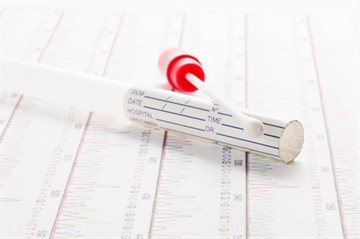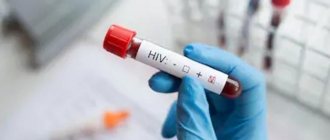About the test. A little science
When a child is conceived, he receives half of the chromosome set from the father and half from the mother. All people have 23 pairs of chromosomes, one pair of which are sex chromosomes, and 22 pairs of autosomal pairs, which contain autosomal markers. Markers are sections of DNA with a very specific localization, i.e. geneticists know exactly where the genes they need are located.
The test is carried out precisely on these autosomal markers. The DNA of the father and the child is analyzed and then compared to each other. As a rule, 16 markers are enough. If everything matches, then paternity is absolutely confirmed. If 2 markers do not match, then paternity is definitely excluded. If 1 marker does not match, then this may be a gene mutation and it is advisable (but not necessary) to analyze the mother’s DNA.
In what cases is a DNA test necessary?
Genetic testing is carried out:
- By court order. When a man refuses to pay child support due to questionable paternity, he is offered a DNA test.
- At the request of the parent. If a father suspects that he is not raising his child, he can initiate a test. DNA samples from the child and the doubting parent will be needed. The consent of the mother or other relatives will not be required for the test.
- In private cases of adoption. Sometimes men find out that they have become fathers some time after the birth of a child. A DNA paternity test will greatly facilitate the adoption procedure.
Anonymous paternity determination
It is not uncommon that paternity must be determined as “quietly” as possible. Nobody wants to start a scandal ahead of time. And if everything is confirmed, then forget this story altogether and move on with your life. In such cases, an anonymous paternity test can be performed. Any information you do not want to include can be omitted. It is enough just to write the degree of relationship (father, child) on the envelopes with samples.
A laboratory that understands the full degree of responsibility and values its reputation securely stores client data on closed servers. And to identify analyses, random combinations of numbers are used - order numbers. You can be sure of the confidentiality of all personal data.
DNA samples in the case of an anonymous paternity test may be different. It is extremely difficult to take an oral swab without being noticed, so non-standard samples come to the rescue. In any, absolutely any biological sample, the DNA is the same and there is no difference from which part of the body the DNA is taken. The accuracy of the paternity test will always be the same, up to 99.99999% for a positive result and 100% for a negative one. Here is an example of the most available non-standard samples:
- Hair with roots;
- A comb if it was used by one person.
- Toothbrush.
- Nails.
- Earwax.
- Razor.
- Cigarette butts.
- Chewing gum.
- Stains on underwear and clothes.
- Snot (but green, transparent liquid ones will not work).
- Blood stains.
- Cutlery, incl. cups.
- Toothpicks.
- Used condom.
These are the most frequently encountered samples in genetic practice. Of course you can expand the list. Qualified laboratory specialists can help with this.
Paternity test cost
It is impossible to do a DNA paternity test for free. With anonymous testing, the person who contacts the medical center pays for the test. In the event of litigation, either the plaintiff or both parties to the proceeding will pay for the test (this depends on the court's decision). The only option for a man not to spend money on an expensive procedure is if he is not interested in having it done and the results are negative. Then the cost of the examination will be paid by the losing party.
The cost of DNA testing depends on:
- Appointments. The cheapest way to do a home anonymous test is from ten to fifteen thousand rubles. A test carried out in court will cost sixteen to twenty thousand rubles (depending on the clinic’s prices).
- Qualities. The more loci tested, the more accurate the probability of paternity (from 99.9 to 99.999) and the higher the cost of testing.
- Number of participants in the procedure. The more genetic material and work for technology and experts, the more expensive (about five thousand per person).
- Urgency. To receive results within one or two working days you will need to pay an average of two thousand rubles.
- Living place. The cheapest place to do the test is in Moscow. In the regions, the cost and waiting time are much higher (for example, in Ufa, a home test costs twelve to twenty thousand rubles, and the waiting time for results is a month).
Establishing paternity for the court
Unlike the information test, the judicial test cannot be performed confidentially. The court will reject such a conclusion. That a DNA paternity test had legal force and served as irrefutable evidence in court, you need to go through a strictly regulated procedure and provide the necessary documents. Below we will consider in detail the types of forensic tests and what is needed to obtain a forensic genetic examination for paternity.
Types of forensic analyzes
Until the court's decision. If a court has not yet been appointed and you only plan to file a claim, you can independently choose a laboratory for analysis. This is very convenient, because... Only you decide where to turn. After going through all the identification procedures, you will be given a full legal opinion from a forensic medical examination. With this conclusion you can go to court and win your case.
By the tribunal's decision. If the court has already appointed a specific laboratory to conduct a judicial paternity test, then there is no other alternative. You will have to contact this organization. However, it is possible to achieve the desired court decision. To do this, you need to submit a request (petition) in advance to schedule a paternity examination at a laboratory convenient for you. Competent laboratory experts will help you draw up such a request or send it by email.
The procedures for collecting samples and identifying study subjects are exactly the same for both forensic and court-ordered investigations. The expert opinions are also completely the same.
Procedure and required documents
Since the conclusion will be submitted to the court and a decision will be made on its basis, it is necessary to prepare documents and appear in person for the collection of samples for all participants in the analysis for identification. It is not necessary for everyone to come together, but everyone must show up.
Documents must be originals. Copies of originals are also allowed, but this fact will be reflected in the laboratory report. Only the judge can decide whether this will affect the court's decision.
Adult children (18 years and older and adults) must bring original passports with them. If the person is a citizen of a foreign country, then an original foreign passport or identification card with a photo and full name.
Minor children must have their original birth certificate with them. If the child is a citizen of a foreign country, then a document replacing a birth certificate in this country.
ATTENTION! If it is not possible to provide these documents, then other papers and cards identifying a person may be suitable. For consultation, you must contact a DNA laboratory specialist.
What is the procedure?
It is not always possible to conduct a DNA test on a voluntary basis. When one of the parties does not agree with the testing of genetic material, the basis will be a court decision made during the proceedings regarding the determination of the payer of alimony or when it is necessary to officially recognize the father.
There are many different ways to test a pair of an adult and a child. The collection of genetic material often occurs through:
- Scraping from the buccal mucosa.
- Analysis of salivary secretions.
However, other material – any tissue of the body or blood – can become a source of comparison and analysis. In most cases, no additional preparation is required from those tested, and the actions of doctors are absolutely safe and painless, unless we are talking about testing the fetus during pregnancy.
Description of how the procedure is carried out:
- Acceptance of samples in the laboratory.
- Conducting a comparative analysis with decoding.
- Preparation of a medical report with conclusions regarding the relationship of those tested.
Behind the simple description of the procedure, there are many legal details related to preparation for testing and the consequences of the established fact of kinship (if the conclusion is positive).
DNA contains many different genes, and comparisons are made by comparing individual sections of the molecule. The coincidence of 14 sites is a reason for recognizing the positive result of identifying kinship, allowing the interested party to further seek through the court certain legal norms related to the determination of paternity.
Not only mothers initiate the procedure in order to bring the biological parent to justice, sometimes fathers themselves want to know for sure whether the child is theirs, and testing during the period of gestation is common, i.e. even before he was born.
DNA during pregnancy
The development of medical technologies has led to the possibility of conducting genetic examinations without waiting for the birth of the baby.
Two methods have been developed and used during pregnancy:
- The non-invasive procedure does not involve any risk to the mother and fetus, involving blood sampling from a vein. It is carried out at any period of pregnancy, starting from the 7th week, when it becomes possible to isolate free DNA of the unborn child. Next, the biomaterial is taken from the putative father and matches or their absence in the compared areas are determined in the laboratory.
- The invasive method is more risky, as it involves collecting amniotic fluid in the period 14-20 weeks, or collecting material through a puncture in the period 9-12 weeks. Before deciding on such a method, parents should compare the degree of risk for the pregnancy and the feasibility of the procedure.
Sample collection and identification procedure
Below we describe “step by step” the entire process of submitting biological material for a judicial test to establish paternity:
- Identification. The specialist will visually check the documents of all study participants. He asks: “Are these your documents?” and “What is your name?” Next, the documents are photocopied and the photocopies are signed by their owners. A parent or legal guardian signs for children. After this, the specialist certifies all photocopies with his signature and company seal.
- Taking photographs. Each study participant and parent/guardian is photographed. Photos are printed and signed by the person depicted in the photo. A parent or legal guardian signs for children. After this, the specialist certifies all photographs with his signature and company seal.
- Biological material is collected. The expert takes a mouth swab from all individuals being examined. ONLY an expert can carry out the fence. It is strictly forbidden to bring samples with you. Envelopes with samples are sealed with the expert’s signature and the company’s seal.
- Protocol. A protocol for collecting biological material is drawn up. It indicates all the individuals from whom samples were taken and each of them signs that he has no complaints about the method of collecting samples. At the end, the specialist signs.
- Information consent to the processing of personal data is issued for each participant. This is the standard form.
On this, clients can be free. As a rule, this entire procedure takes 30-40 minutes. The expert completes the design. He puts all the documents and samples into one large paper envelope, seals it, puts his signature and the company seal on the fold. This envelope is then sent directly to the DNA laboratory for testing.
How much does the procedure cost?

The cost of the study depends on several factors:
- home visit or visit of the interested person to the clinic;
- the participation of several persons who act as putative fathers;
- type of material used;
- prestige of the clinic;
- region of location.
The average cost of analysis is 0 rubles. There are clinics where the cost reaches 70,000 rubles. Additional fees may be charged for urgency or other circumstances.
Getting the result
Within 5-6 working days, forensic geneticists issue a conclusion. This is not a simple one-page document, but a bound 20-30 page report. It contains all the information obtained during the delivery of samples, readings from instruments, a description of the judge of the lawsuit and the opinion of an expert in establishing paternity. The accuracy of the analysis is 99.99999%, which is 1000 times more accurate than what is required by law in court. Therefore, you don’t have to worry about the reliability of the analysis. The conclusion can be issued in person or sent from the laboratory directly to the court.
"Pitfalls" of judicial establishment of paternity
- Be sure to check the license of the laboratory in which you will conduct the analysis. In addition to a medical license for the right to engage in forensic medical activities, there must also be documents for the geneticists themselves. They must have valid forensic certificates.
- Do not attempt to take samples yourself. If someone says this is possible, don't believe it. The court will reject such a conclusion.
- The losing party will have to pay for the study, so try to agree on a 50/50 payment in advance.
- The losing side will try to protest the result 99% of the time. Therefore, ask the company where you are doing the test for copies of licenses and certificates in advance.
- There is no need to take samples from the mother. If anyone insists on this, then they are scammers. Be carefull!
Life - forensic test hacks
- It is not necessary for everyone to come at once to give samples. If the relationship is tense, you can do this on different days. This practice is quite common.
- You can order a copy of the forensic genetic report. As a rule, such a document costs 400-500 rubles. But your lawyer will always have tips and materials to work with.
- Absolutely any official parent or guardian can initiate judicial establishment of paternity. The mother's consent/non-consent is not required to do the test if the father is included in the birth certificate.
- If the trial has not yet begun, then it is better to independently choose a convenient laboratory and do a pre-trial test. It has exactly the same legal force as a court decision. This way you will have room to maneuver.
- You cannot force your father to appear in court. But you can submit an application and the court will order an examination. If the father does not show up for samples 3 times, he will automatically be considered a loser.
The DTL Genetic Research Center has conducted more than 1,000 forensic tests in more than 200 cities of Russia. We can guarantee the accuracy and reliability of the research. Not a single expert report has yet been rejected by a court. Specialists know all the intricacies of preparing forensic tests and are ready to help with free advice. Our hotline is open daily!
Article edited: 2020-05-11
webninja
string(0) ""







